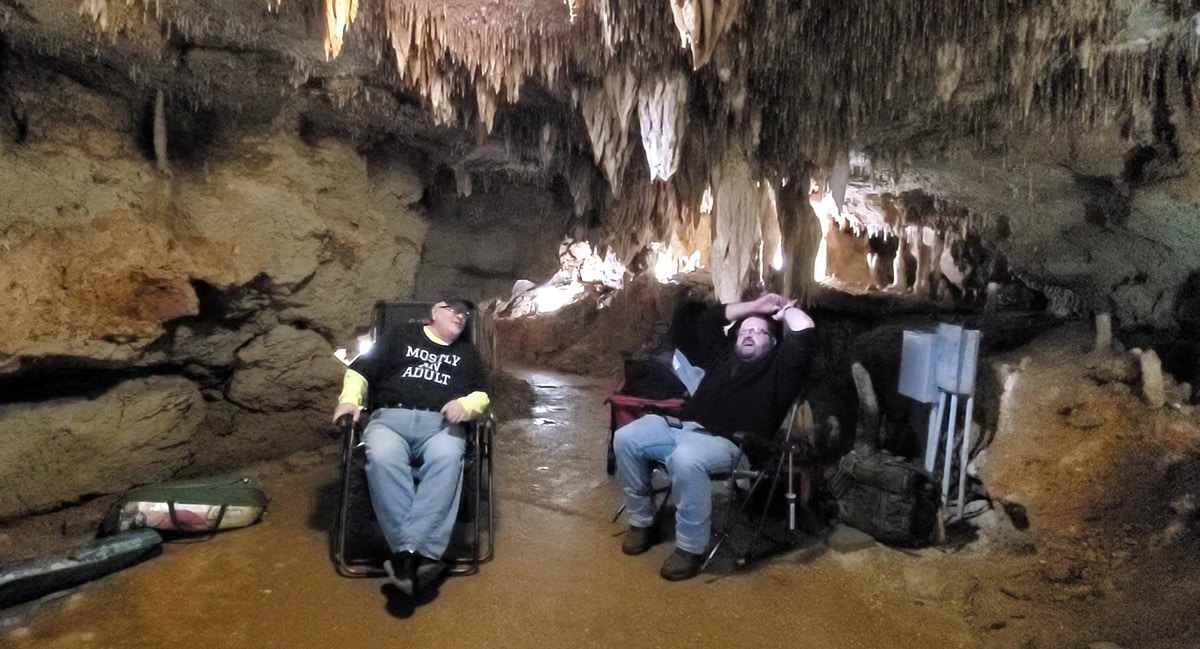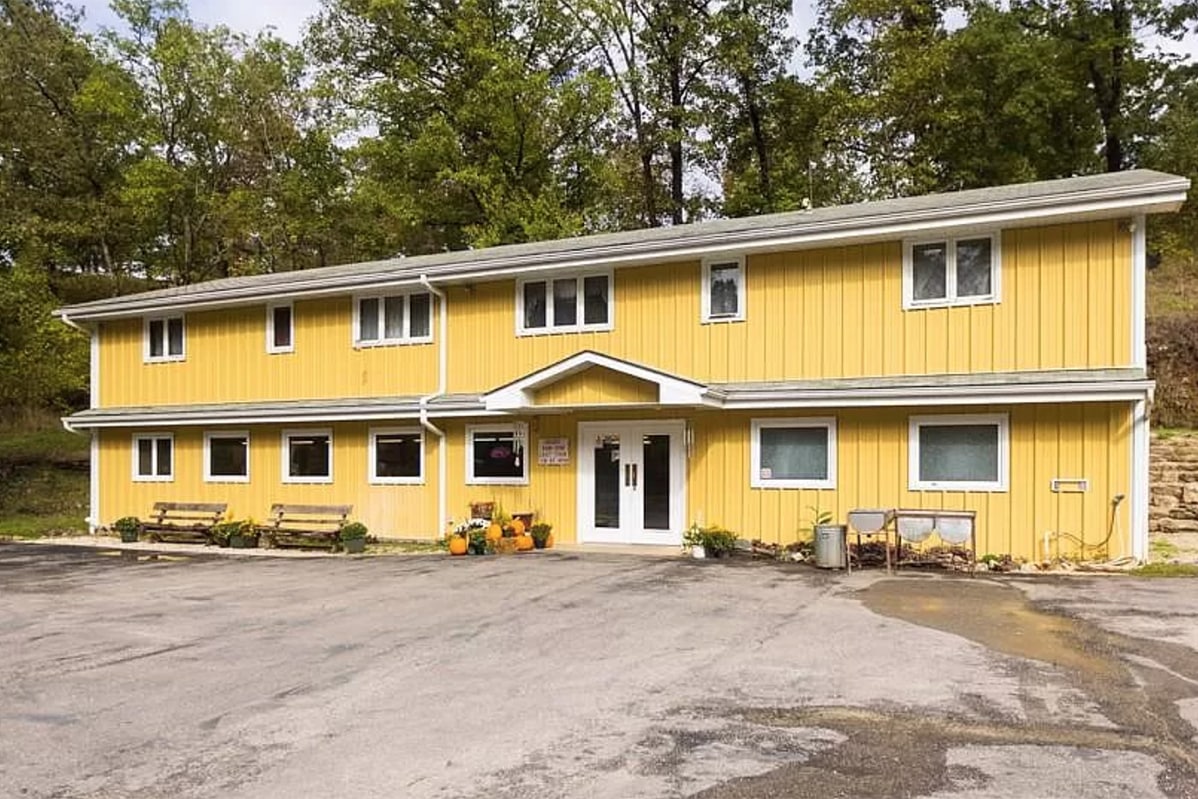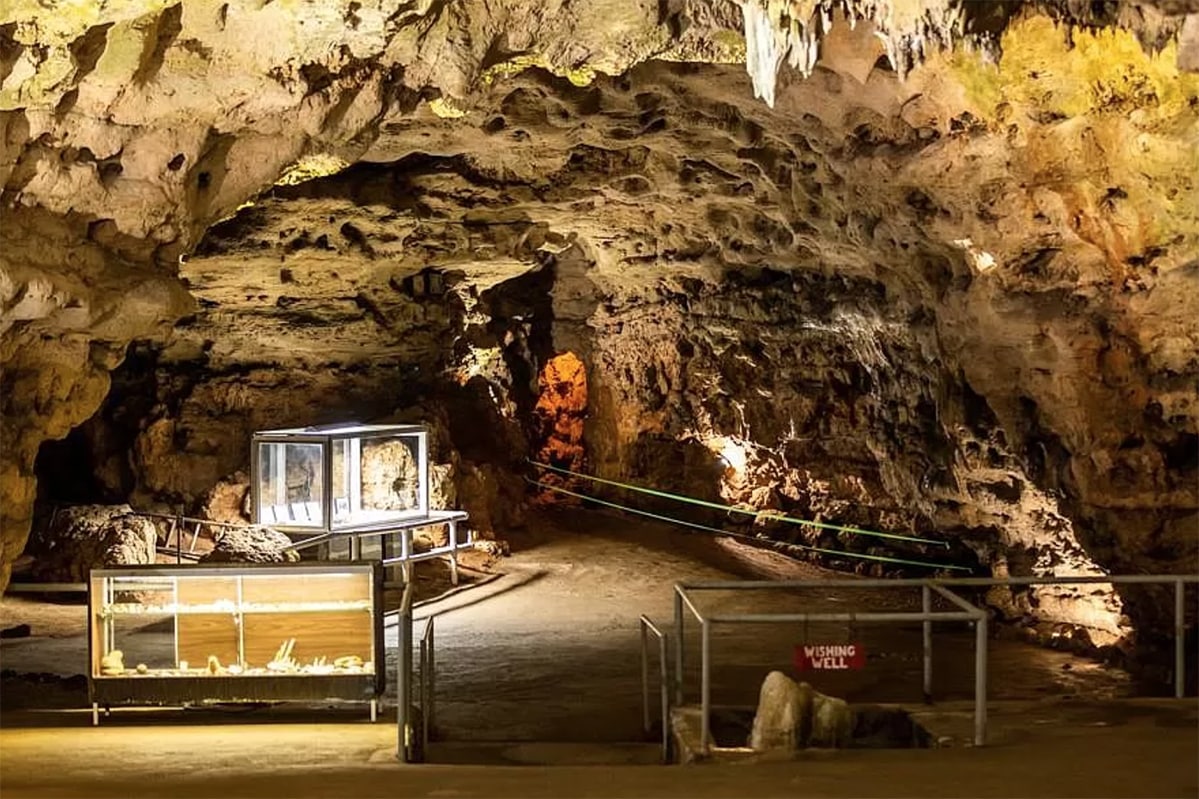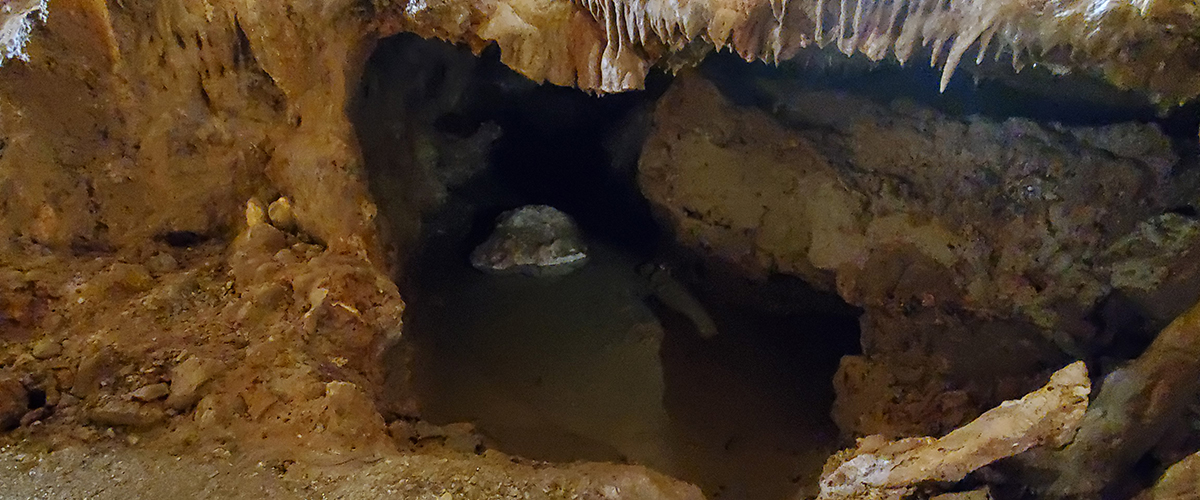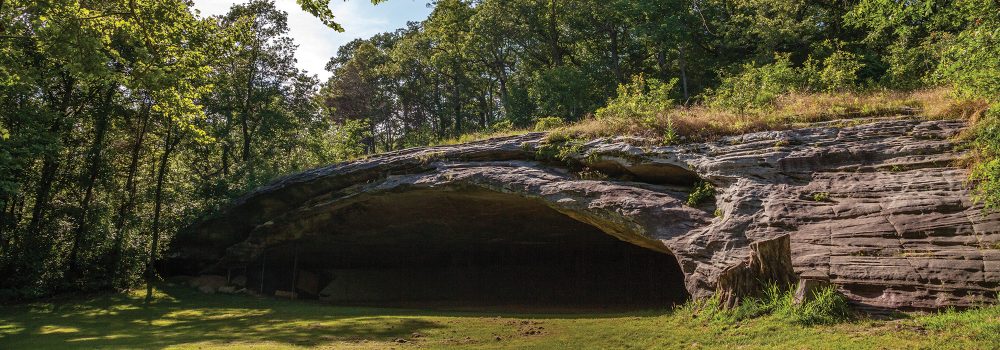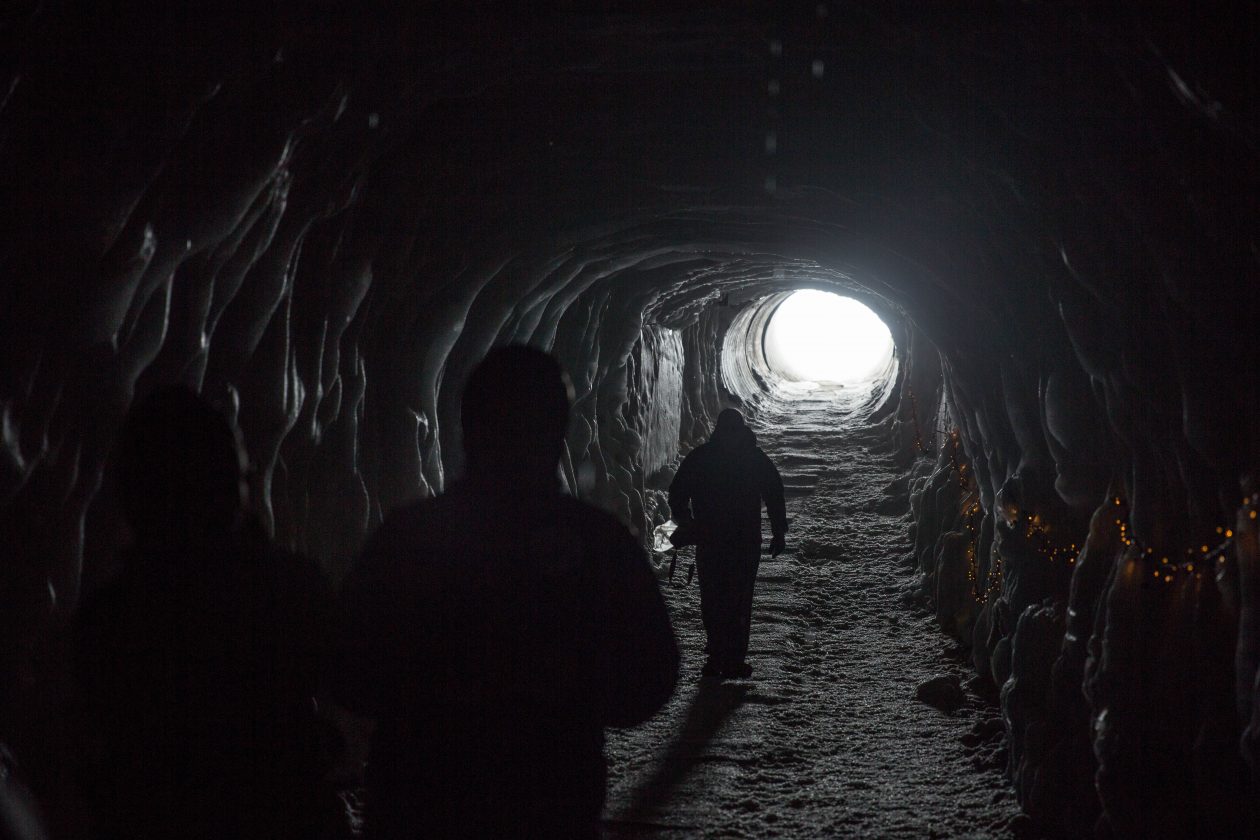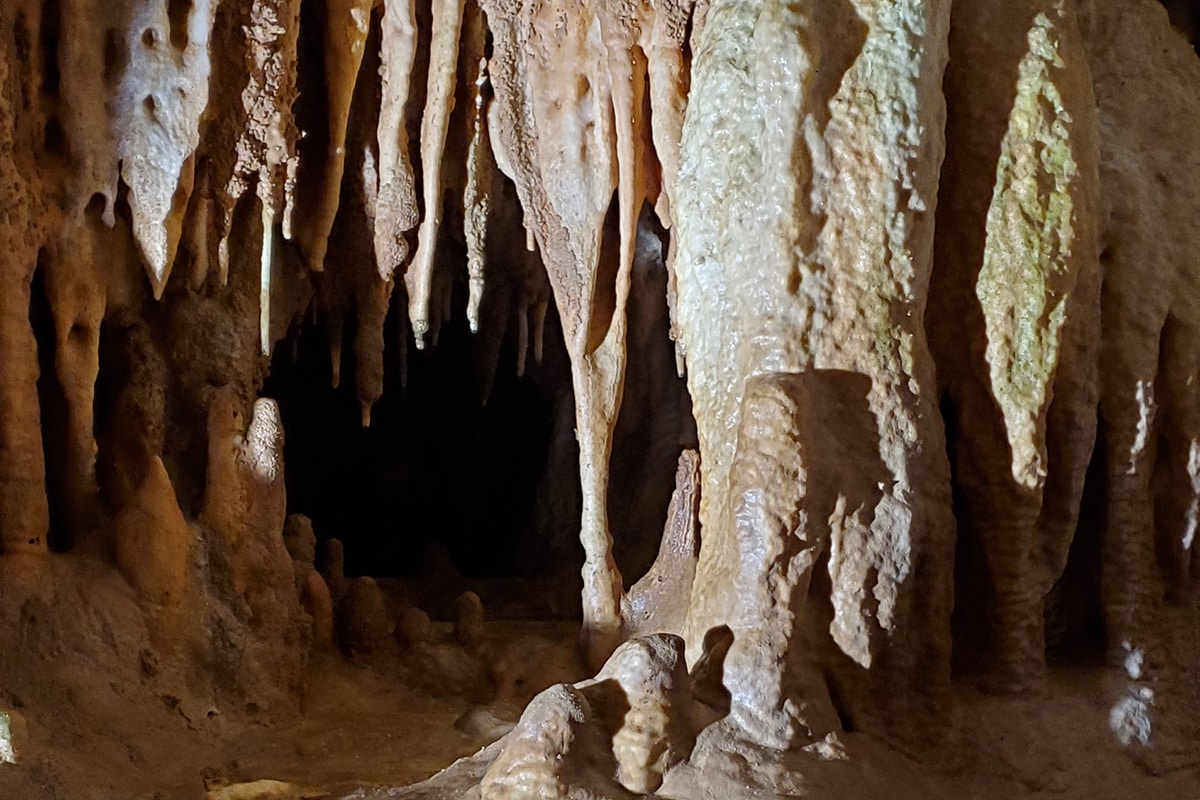
This story originally appeared in the July/August 2022 issue of Missouri Life magazine.
MIDNIGHT. THE ASTONISHING PITCH BLACKNESS INSIDE THIS 48-MILLION-YEAR-OLD CAVE WAS EXPECTED. BUT SOMEHOW IT’S STILL SURPRISING. THERE’S NO GENTLE BLUE GLEAM FROM A DIGITAL SCREEN, NO AMBIENT LIGHT SEEPING UNDER A DOOR, NO HINT OF A GLOWING BEDSIDE CLOCK.
Even more mesmerizing are the sounds in this always-midnight world 55 feet underground and a half-mile from the entrance. It’s not a silent world. The rhythmic drips, plops, and plinks of calcium-laden water slowly creating and lengthening stalactites and stalagmites is a surprising though not annoying aural experience.
And then there’s Zeke, my tent-mate and nephew, sawing logs in his slumber, no doubt especially gratified with the outcome of our Scrabble rematch about three hours earlier. He was wise to bring noise-canceling earbuds based on my warning that I’d be snoring without my CPAP machine. (Thank you, sleep apnea.) He, however, failed to mention his impressive snoring acumen.
Here we are, tucked away in Jacob’s Cave in Morgan County near Lake of the Ozarks, still several hours from sunrise—which the innards of this ancient cave have never seen. It’s a constant 52 degrees, a few degrees cooler than most caves due to the dripping ceiling and walls, which produce noticeable humidity and a glint of gossamer armor, as if protecting the thick rock walls. Any sort of breeze, no matter how gentle, would make this environment unbearably cold, but Zeke and I are comfortable.
By the way, the cave and surrounding land that hosts the popular and much-populated Jacob’s Cave Swap Meet a few times a year is for sale. For a mere $3.4 million, it can be yours—or mine. Jacob’s Cave, located between Versailles and Gravois Mills off Highway 5 on State Road T, was the first commercialized cave in the Lake of the Ozarks area.
Cave owner Frank Hurley lives above the shop that opens into the cave. I offered to pay him $1,000 as a downpayment, if he’ll carry the note. He laughed, declining my offer and terms to buy the cave that he has owned since 1965.
“I didn’t know anything about caves or geology or anything like that until I came down here,” Frank says. He was living in Iowa when he heard the cave was for sale in 1965. He’s apparently done well with the cave and adds that the cave “has paid for itself at least twice.”
KNOWN AS THE CAVE STATE
Missouri is known as The Cave State for good reason. It’s not tops in the country for the number of caves—that title goes to Tennessee with more than 9,000—but the Show-Me State has more than 7,000. Those are the ones we know about. Guesstimates for undiscovered caves range from a few hundred to a few thousand. After all, caves are still forming and also collapsing, as they have done for millions of centuries.
Meramec Caverns near Sullivan is the state’s longest cave with 4.6 miles of mapped caverns and passages. By comparison, the longest cave in the United States and on the planet is Mammoth Cave in Kentucky, a system of caverns and passageways at least 420 miles long. Marvel Cave, which birthed Silver Dollar City in Branson, is the state’s deepest cave at 500 feet.
I am familiar with one particular feature of Mammoth Cave: the so-called Bottomless Pit, a 105-foot-deep hole in the cave. My mother was certain that it would swallow up carefree six-year-old me when my family visited Mammoth Cave more than a half century ago. That experience was the key to sparking and unlocking my lifetime fascination with caves.
No such danger exists in Jacob’s Cave. You’d have to be about two feet tall to squeeze into any tunnels, most of which only go about a hundred feet before petering out.
Considering the number of caves in Missouri, finding one for an overnight experience should have been a cinch, or so I thought. Ninety-eight percent of Missouri’s caves are on private property. Only a handful are public. Most of us are familiar with commercial or show caves, from Bridal Cave at Camdenton, Fantastic Caverns (a drive-thru cave north of Springfield), the aforementioned Marvel Cave, and Onondaga Cave and Meramec Caverns, located just twenty-five miles apart in Crawford and Franklin counties, respectively.
With 68 known species of tiny invertebrates, bats, salamanders, and other critters, Onondaga Cave is perhaps the best example of a vibrant cave ecosystem. (Jacob’s Cave has an abundant population of cave salamanders—blind of course—that eat algae in the stream that runs throughout the cave and on both sides of the concrete walkway.)
Missouri State Parks operates four of the Show-Me State’s commercial caves: Fisher Cave at Meramec State Park, Ozark Caverns at Lake of the Ozarks State Park, and Onondaga and Cathedral Caves at Onondaga State Park.
Commercial caves, including Jacob’s Cave, are inspected annually by the Missouri Department of Labor’s Mine and Cave Safety and Health Section.
CLOSED TO PROTECT BATS … FROM US
Finding a cave for an overnight adventure was a difficult proposition if only because of the tiny, winged mammals that love this just-right climate: bats. An epidemic of white-nose syndrome—a fungus that has already killed millions of bats in the United States—and the endangered status of many bat species has put the kibosh on human activity in caves. It seems that we humans are one of the primary vectors for spreading the disease.
I had sought out a privately owned wild cave and initially eschewed commercial or show caves. The eight caves at the top of my list were all off-limits in compliance with a Missouri Department of Conservation request to keep humans out. Though often feared, bats are vital to humans for insect control and plant propagation and pollination (mostly in tropical climates). If you don’t like mosquitoes, just imagine a world without bats.
Jacob’s Cave manager and chief tour guide Marvin Woolery, a mainstay of the cave operation since 2009, says there’s rarely a bat in the cave, which has had a covered entrance through a gift shop since the 1940s. Yet during our visit, a lone brown bat, not more than a couple inches long, clings to a high ceiling. When I was scouting out caves for this adventure, seasoned spelunkers cautioned against sleeping unsheltered because bats, which can carry rabies, have been known to nip people without being noticed.
CONKED MY HEAD
Therefore, the tent is necessary, though only a couple of spots in Jacob’s Cave afford space for erecting the canvas home. Our gear consists of the tent, Zeke’s cot and chair, my zero-gravity chair/cot, my digital camera in its case, a tripod, a soft-sided cooler with snacks, bottled water and Diet Coke, and a bag of empty water bottles for, um, overnight “relief” if needed. (My GoPro camera, ready to strap onto my forehead to record our adventure, was useless without its memory card.)
I assured Marvin and Frank that they wouldn’t know we’d been there, and we kept that promise.
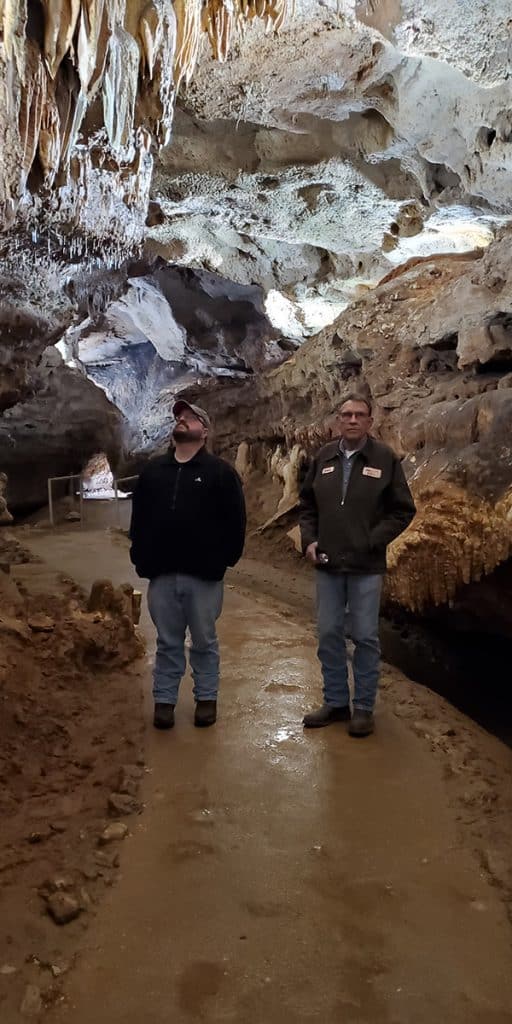
In some ways, camping out in Jacob’s Cave felt a bit like cheating the concept of an overnight cave experience, because it is fairly well-lit (we turned the lights off from 10 PM to 7 AM), the wide walkway is paved with concrete, and there are no twists and turns.
When I was a young lad, I explored many caves along the Gasconade River at Mt. Sterling and near Vienna. My dad trembled when he found out, and he insisted I stop, telling me that one of his worst nightmares was based on the terrible reality of wanderlust luring some kids—and adults—into caves to become fatally lost in a labyrinth of tunnels.
No such danger exists in Jacob’s Cave. You’d have to be about two feet tall to squeeze into any tunnels, most of which only go about a hundred feet before petering out, Marvin says. He also warned a few times to “watch your head,” because the ability to duck down while getting through some narrow gaps on the tour is paramount. Forgetting that edict, my only brush with danger was conking my head just before reaching our campsite about 30 feet from the back of the cave.
STEPPING INTO A PREHISTORIC MUSEUM
The advantage of camping in Jacob’s Cave is that we know where the light switches are. In some ways, the details, colors, and formations—and even the shadows—are more captivating with lantern or flashlight illumination. Marvin gave us a quick color-coded explanation of the formations, formally called speleothems. White represents calcite; black is manganese; red is iron oxide. Frank points out a rare type of fossilized coral—on the ceiling, of all places—as further evidence that Missouri was once covered by a massive sea that in prehistory stretched from the area between what is now Louisiana and Minnesota.
Also visible in the cave are six layers of flow stone that Marvin says represent six ice ages.
Zeke and I share “ooh” and “aah” retorts as Marvin points out the length of the ice ages, which geologists determine by studying the depth of the layers, and how the melting ice helped form the cave. There’s also evidence of three major earthquakes, including the notorious New Madrid earthquakes of 1811 and 1812.
The Missouri Department of Natural Resources website explains that caves share a basic formation story. Mildly acidic rainwater slowly enters porous bedrock, eroding limestone to form underground caverns, and continuing to drip and seep to form pencil-thin soda straw stalactites, flowstone, massive columns where stalactites and stalagmites meet, and sundry formations that are sometimes unique to specific cave systems. Missouri is well-known for this type of karst topography, which is especially critical to water quality for human consumption and also vulnerable to land development and other human activity.
Jacob’s Cave opened as a tourist attraction in 1932, with wooden planks lining the muddy cave floor and kerosene lanterns providing light.
The gift shop has a wide selection of native minerals, mozarkite (the official state rock), geodes, galena (lead), and barite (tiff), as well as fossils, agates, crystals, and a selection of novelty gifts and souvenirs. Incidentally, barite and galena were the minerals for which Jacob Craycraft was prospecting when he discovered the cave in 1875.
Jacob’s Cave is a living and prehistoric museum, with bones and fossils of mammoths, saber-toothed tigers, ancient bears, and peccaries found here. I was a bit disappointed that there are no legendary tales of hauntings here, though Marvin says some of the tour guides have reported seeing Jacob Craycraft as a thin man with a long, white beard.
“What if we see him?” I ask Frank. He replies, “Just say ‘hi’ and be nice.”
PLAYING SCRABBLE
After two trips to haul in our gear, squeezing and ducking to navigate narrow paths and to avoid prehistoric speleothems, we’re tuckered out. We’ll rest, set up the tent, then spend the evening and night—maybe all night?—exploring the cave and, of course, playing Scrabble.
That plan quickly evaporates, and we spend about ninety minutes catching up on each other’s lives, talking about relationships and parenthood, and pining for one of our favorite shared interests: Major League Baseball. On this early March expedition, when teams should be halfway through the spring training schedules, the players are still locked out by team owners. We blame the owners for this debacle, yet have limited sympathy for the millions-of-dollars players.
Zeke and I both favor the universal designated hitter. We’re not so sure the infield defensive “shift” should be outlawed, and we agree on having a pitch clock to speed up the pace of the game.
Clearly, this game will be my death by two- and three-letter words, a skill Zeke honed in Iraq.
After getting the tent set up—taking extra care not to brush against prehistoric stalactites hovering over the top—we arrange our sleeping accommodations and return to our folding chairs. Maybe we’ll do some exploring later, but now the top priority is a Scrabble rematch 20 years in the making.
Now for this belated introduction to my nephew, Thomas Ezekiel Assel, age 41. Though I am about 18 years older, we share uncanny similarities, the same questionable sense of humor, a love of words and language, a love of God and a cappella music, and an affinity for the ironies of life. I’ve only known him as “Zeke,” though he eventually started using “Tom” in his late teen years, and that’s the name most of his acquaintances call him. But it all sounds too grown up to me.
And I’m adamantly opposed to growing up.

Sgt. Assel of the United States Marine Corps was deployed to Iraq for eight months in 2004. A night or so before he set off in July 2001 to learn Arabic at the Defense Language Institute at the Presidio of Monterey in in Monterey, California, we pulled an almost all-nighter, capped by an epic Scrabble game that I won by a score of 304-300—or something like that. It was the first—and only—time I’d beaten the brilliant wordsmith.
I’ve avoided a rematch for more than two decades.
Zeke has come equipped with the Scrabble travel board and, of course, the Scrabble Player’s Dictionary. In my mind, however, if Zeke spells a word, it’s a word. On the other hand, I might get creative with my tiles and force a challenge from him. I’m on the defensive from the start, angling to keep Zeke from parlaying select tiles to extend a word on the board to become a double- or triple-score letter or word. The best I can do to start is spell “TAIL” for eight points. A stalactite drips on my neck. Maybe that’s a terrible omen?
LOSING THE GAME
The Scrabble board is our sole focus. After spelling a few four-letter words—no, not those words—Zeke blocks me from using a triple-letter J. The maestro skillfully uses two tiles to spell three two-letter words on consecutive moves, almost filling the bottom right side of the board. Clearly, this game will be my death by two- and three-letter words, a skill Zeke honed in Iraq. I remember seeing a photo of him playing Scrabble with his unit in Husaybah, Iraq. Funny thing. Zeke said he was safe. But he was wearing his Kevlar helmet and flak vest, which I later learned was customary gear for when Iraqi forces were lobbing mortars their way.
Our game is somehow almost neck-and-neck until he spells “KLEPTO” and pulls away for good. His moves are quick but deliberate. My moves are slow as calcite forming a stalactite.
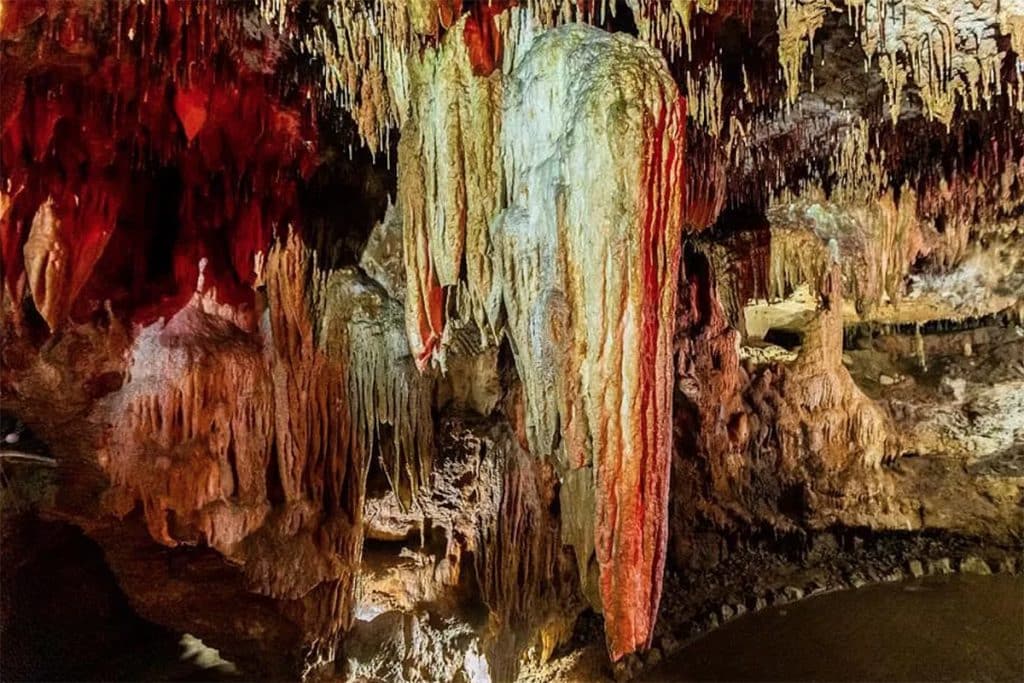
“Are you just going to slow play me until I fall asleep and you declare victory?” he wonders. “Talk about needing a pitch clock.” I protest his trash talkin’, but I have no witty comeback—or the necessary letter tiles to make this a competitive game. In the end, the final word comes from Zeke. Considering the sounds of silence that will soon follow, his tiles produce another touch of irony.
Zeke’s final word is “NOISE.” And it seals his crushing 373-254 victory.
Time to do some more exploring? Neither of us suggest that as the next step. The deep serenity, connectedness, and sacredness of this space are a drowsy mixture. Zeke turns off the lights, and we tuck ourselves in at 10 PM. I think he slipped into deep sleep by about the count of ten. I lie awake for the next two hours plus, entranced by the melody of drips, drops, and plinks, imagining this space millions of years ago. I’m also smiling with pride—is that a tear on my cheek or stalactite drop?—from spending this precious time with my tent-mate.
Snore away, you prince among men.
Visit Facebook.com/MissouriLife to see the videos I made with Frank before going into the cave for the night and after emerging in the morning around 8:30 AM. (We wanted to be out of the way for the 9 AM to 4 PM tour times.) What started as a quest to spend 24 hours in a cave wound up as a 15-hour experience. I’d do it again, though I think a nap is on my itinerary when I get home.
Credit also goes to Missouri Life magazine freelance writer and life-time storyteller, Ray Speckman, who in a way greased the skids for me to select Jacob’s Cave for this experience. Ray wrote a story about the Jacob’s Cave Swap Meet for MissouriLife.com. Ray and his partner, Joyce, also arranged for us to eat breakfast at Chances ‘R’ in Laurie with a gift certificate from the restaurant. Let’s just say that wonderful restaurant did the Lake of the Ozarks area and biscuits and gravy proud. The amount, quality, and price of the food was astounding, and I give it a 100 percent recommendation.
Jacob’s Cave is ageless yet still growing. It continues to be a source of mystery, stories, exploration, and adventure, beckoning us to enjoy its splendor, while also pleading with us to acknowledge—and protect and preserve—its remarkable ecosystem.
May it still be such a source of amazement a million years from now. To learn more, visit JacobsCave.com.
Learn more about other show caves in Missouri with this story.
Related Posts
Missouri’s Show Caves
With more than 6,400 recorded caves, including twenty show caves that are open to the public for guided tours, travelers and spelunkers around the world know Missouri as The Cave State.
Hiking Graham Cave State Park
Head over to Graham Cave State Park to walk in the footsteps of early Missourians.
Show-Me State Caves: 5 of our favorites
With more than 6,400 recorded caves, including twenty show caves that are open to the public for guided tours, enthusiasts around the United States know Missouri for its many caverns.

